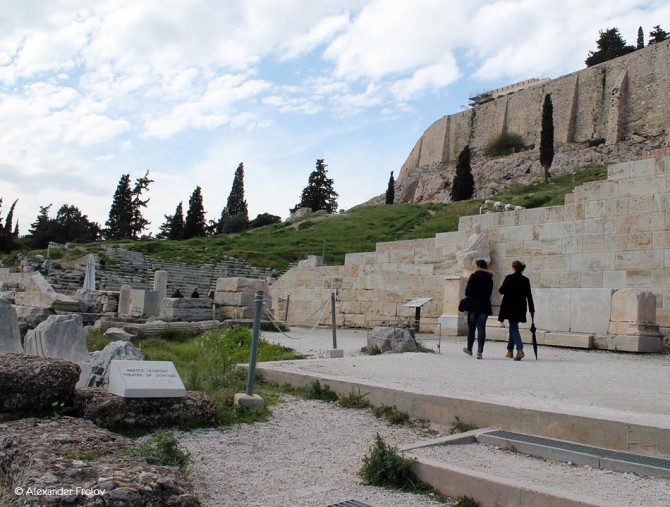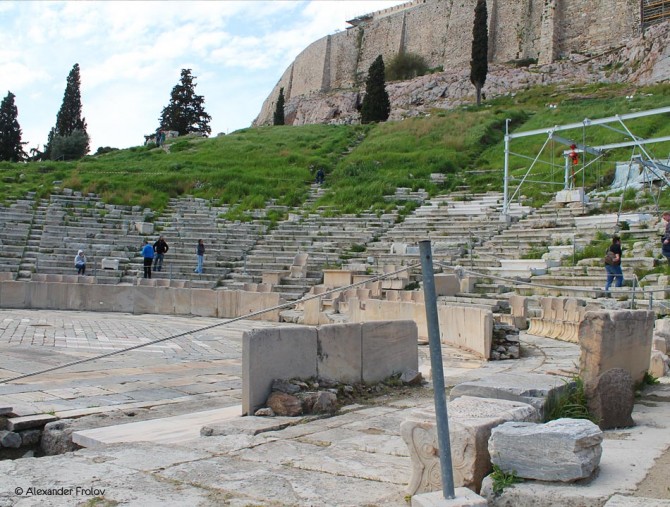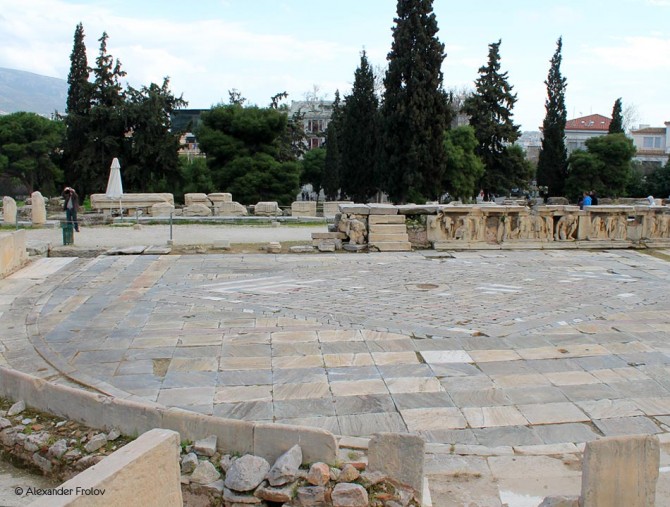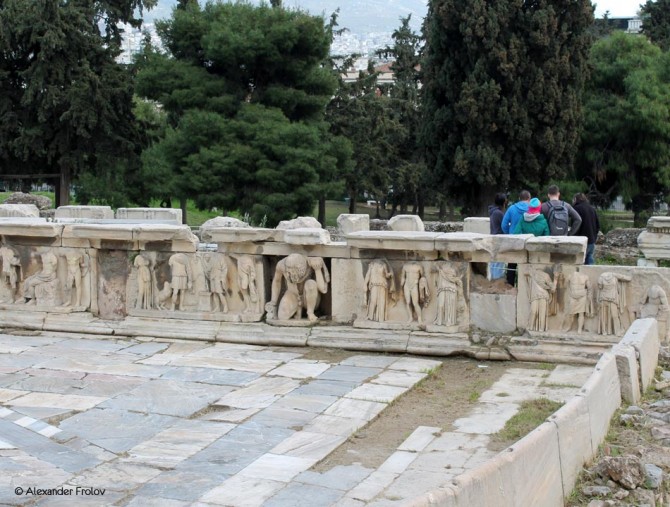Театр Диониса
Правивший тогда Писистрат, был большим почитателем бога Диониса – покровителя веселья, виноделия, религиозного экстаза и оргий. Благодаря стараниям правителя Афин, на южной стороне Акрополя сначала было построено Святилище Диониса Элевтерея, в котором стояла древняя статуя божества, а спустя некоторое время старый храм было решено заменить новым. Теперь в центре нового Святилища возвышалась, выполненная из слоновой кости и украшенная золотом, новая статуя бога Диониса. Недалеко от храма по указу Писистрата была построена танцевальная площадка, которая впоследствии превратилась в Театр Диониса.
Изначально театр был построен из дерева, а выступления проходили дважды в год - во время Малых Дионисий и Великих Дионисий.
Во время Великих Дионисий в Афинах проводились театральные состязания. Обычно состязались три автора трагедий. Каждый из участников ставил три трагедии и одну сатирову драму, в шутливой форме обыгрывавшую мифологический сюжет. Состязались также авторы комедий, ставивших по одной пьесе. Результаты фиксировались в особых надписях - дидаскалиях, которые хранились в афинском государственном архиве.
Около 326-325 годах до н. э. театр был реконструирован: деревянная сцена и ряды сидений были заменены на мраморные. Каменные сидения размещались в 67 рядов, достигая основания Акрополя. Театр теперь вмещал до 17 тысяч зрителей, что в то время составляло около половины афинских граждан. Кресло во втором ряду принадлежало императору Адриану.
Театр перестраивался и в римскую эпоху в I веке н. э., в том числе под цирковые и гладиаторские представления. Отсюда высокий бортик перед первым рядом. С художественной точки зрения лучшее в развалинах театра - скульптурный фриз времен императора Нерона с забавными сатирами.
После вторжения герулов в 267 году н.э. здесь по большей части проводились городские собрания. примерно в V веке н.э. к театру была “пристроена” базелика, а площадка для оркестра использовалась в качестве ее двора.
Как добраться до Театра Диониса вАфинах:
- на метро, станция Акрополи
Часы работы: 8:00-20:00, ежедневно
Цена билета: 2 евро (1 евро льготный), также посетить Театр Диониса можно по билету за 12 евро, дающему право посещения Акрополя и других важнейших археологических сайтов Афин
Фото и текст: Александр Фролов
Theater of Dionysus
With the Acropolis as its background, the Theater of Dionysus is the most important known outdoor theatrical space of the Ancient Athens. It was dedicated to Dionysus, whose temple was built at the south of the theater. Although the biggest part of the today’s remains belongs to the memorial configuration of the theater from the ruler of Athens, Lycurgus, in the second half of the 4th century BC, the core of the monument dates back to the 6th century BC.
The story of the theater began after the construction of the archaic temple of Dionysus (in the second half of the 6th century BC), when the Athenians flattened a circular space, on the hillside of Acropolis at the north of the temple, in order to officiate the religious events in honor of the god. In the beginning, the spectators were sitting on the ground on the slop of the hill around this circular space (known as orchestra), but later wooden seats were added. Just for the record, the Tragedy was born from the circular dithyrambic dance of the worshipers of Dionysus.
During the 5th century BC, the wooden seats were replaced by stone ones, while the first scales have been added. The original construction of the first theater was very simple, and as it is believed the most changes throughout the years have been occurred on the orchestra.
In the second half of the 4th century BC, Lycurgus decided to radically reshape the theater, which was entirely rebuilt with stones and was extended to the root of the Sacred Rock of Acropolis. It is believed that at that period, the space capacity of the theater was 15,000-16,000 spectators, while in the first row of seats, the so-called presidency, there were 67 marble thrones, each of which bore the engraved name of the official person for whom it was intended. The new theater was indeed impressive.
In the middle of the first century AD, in the Neron’s times, the stage was restored, since the theater had suffered severe damages a few years earlier (in 86 BC) during the raid of Sulla. New changes had occurred somewhere between the middle of the 2nd and the 3rd century AD, when a high logeon was added in front of the orchestra, adorned with relief plaques, derived from an older unknown monument of the 2nd century AD, which depicted scenes from the life of Dionysus.
After the invasion of the Heruli in 267 AD, the theater was used mostly for the concentrations of the Church of Municipality (which was the dominant operator of the Athenian Democracy, where the citizens were gathered to take decisions for their city and pass new laws). Around the end of the 5th century AD an aisled basilica was erected over the east of the theater, while the orchestra was used as a yard.
The Theater of Dionysus is part of the monuments located at the South Slope of Acropolis.
Theater of Dionysus, South Slope of Acropolis, Athens, metro station Acropolis. Visiting hours: Daily, 8:00-20:00. Last entrance: 19:30. Ticket prices: Full: 2 euros, Reduced: 1 euro. Special ticket package: Full: 12 euros, Reduced: 6 euros. Valid for: Acropolis of Athens, Ancient Agora of Athens - Areopagus, Archaeological Museum of Kerameikos, Hadrian’s Library, North Slope of Acropolis, Kerameikos, Museum of the Ancient Agora of Athens, South Slope of Acropolis, Olympieion, Roman Agora of Athens.
Τext: Marilou Pantazi





